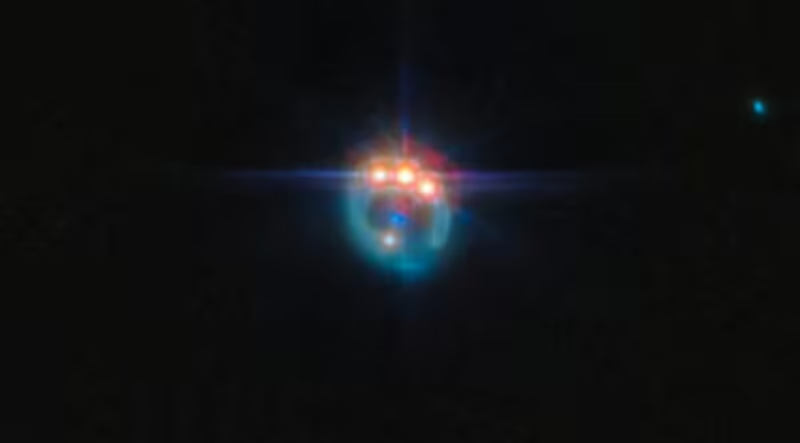Collisions of galaxies are fundamental events in the universe. They occur when two systems entangle stars in a cosmic dance. They also cause spectacular mergers of supermassive black holes. The result is a highly modified galaxy and a unique supermassive black hole. These massive events are the main force in the evolution of galaxies. Small galaxies merge in this way to form larger galaxies. Such mergers have been occurring since the earliest ages of space-time.
Galaxy mergers continue today. Our Milky Way continues to absorb smaller ones and will collide with the Andromeda Galaxy in a few billion years. When this happens, the supermassive black holes of both galaxies may also merge.
We can’t see the entire process from start to finish, as it takes millions of years to complete, but that doesn’t stop astronomers from searching for and finding evidence of colliding galaxies and supermassive black holes.
The latest discovery used the Hubble Space Telescope (HST) to detect three bright visible-light “hot spots” deep within a pair of colliding galaxies. These targets lie relatively close to us, only about 800 million light-years away.
Astronomers followed up on Chandra observations with radio data from the Carl H. Jansky Very Large Array.
Galaxies with bright nuclei, called active galactic nuclei (AGNs for short), tend to be very far away. They can often be seen earlier in spacetime. Being able to study a galaxy and a pair of supermassive black holes colliding in the nearby “modern” universe is a good time to study the mechanics of such an event.
Detection of first collision of supermassive black holes
The discovery of the impending cosmic collision came when HST’s Advanced Camera for Surveys detected three optical diffraction hotspots at the center of the colliding galaxy, called MCG-03-34-64. Two of these hotspots appear to be very close together, only about 300 light-years apart. They track the presence of oxygen in the core. It is being ionized by something very energetic, and the hotspots have astronomers baffled. (The third hotspot is not exactly clear.)
“We didn’t expect to see anything like this,” said Anna Trindadi Falcao of the Center for Astrophysics at Harvard and the Smithsonian Institution in Cambridge, Massachusetts. “This image is not a common event in the nearby universe, and it tells us that there is something else going on inside the galaxy.”
Falcao and his colleagues wanted to know what was causing these bright spots, so they used the Chandra X-ray Observatory to focus on the event.
“When we looked at MCG-03-34-64 in the X-ray spectrum, we saw two separate, powerful sources of high-energy radiation that coincided with the bright optical points of light observed by Hubble. We pieced these together and concluded that we were probably looking at two supermassive black holes close together,” Falcao said.
The team also found observations of these objects in archived radio telescope data. These powerful radio emissions provided evidence that a pair of black holes exist and are approaching each other.
“When you see bright light in optical, X-ray and radio waves, many things can be ruled out and concluded that it can only be explained by nearby black holes,” Falcao said. “When you put all the pieces together, you get a picture of the AGN binary.”
Future collision
These supermassive black holes at their center will collide in perhaps a hundred million years. Each is at the center of a galaxy. As these galaxies get closer, the black holes at their hearts will start to interact. Eventually, they will explode into a powerful event that will emit gravitational waves as part of the process.
Astronomers suggest (through simulations and observations) that merging galaxies with supermassive black holes causes a lot of activity. During the collisions, interstellar gas flows toward the galactic centers.
Other regions are also contracting, and both actions trigger bursts of star formation. Some gas also accumulates above the central supermassive black holes, causing emissions to increase as material spirals through the accretion disk.
These mergers occur all the time in the universe. Models of galaxy evolution combined with observational data suggest that many AGNs at the hearts of galaxies undergo mergers. Collisions between pairs of supermassive black holes in these AGNs also suggest that these black holes grow by merging.
Collisions of supermassive black holes and future detections
Understanding mergers of nearby AGNs, such as those observed in MCG MCG-03-34-64, offers a unique window into the final stages of what astronomers call SMBH binary mergers. Such events are, and will remain, the primary means of measuring the impact of these mergers. They will provide a broad avenue of research using future gravitational wave detectors as well as observatories sensitive to light across the spectrum.
These detections will require improved versions of the Laser Interferometer Gravitational-wave Observatory (LIGO), which made its first detections only a few years ago. Gravitational waves produced by the mergers of supermassive black holes will be the target of future instruments such as LISA (short for Laser Interferometer Space Antenna).
Three space detectors will be positioned millions of kilometers apart to detect long-wavelength gravitational waves emitted by colliding supermassive black holes like MCG-03-34-64. Since these mergers occur all over the universe, this will be a rich field of study that will greatly contribute to our understanding of galaxy mergers as part of cosmic evolution.













